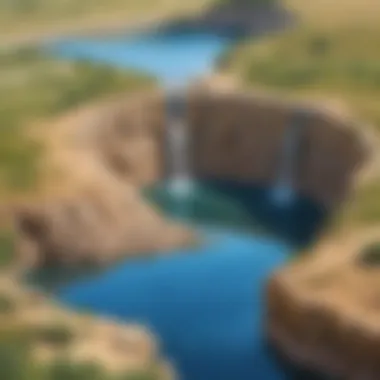Exploring the Intricacies of the Water Cycle


Intro
Water is essential for life. Understanding where it comes from and how it moves through the environment helps us grasp its importance. The water cycle shows the movement of water in various forms, such as vapor, liquid, and ice. This cycle is crucial for weather patterns and ecological balance.
Science Fun Facts
Here are some interesting trivia about the water cycle:
- Did you know? About 71% of the Earth’s surface is covered in water. Only a small fraction is available for drinking.
- The water cycle is continuous. Water moves from one place to another without a fixed beginning or end.
- Water can exist in three states: solid, liquid, and gas. Changes in temperature and pressure affect its state.
"Water is the driving force of all nature." - Leonardo da Vinci
Interesting Trivia and Facts
- A single drop of water can take thousands of years to travel from the mountains to the ocean.
- The average person uses approximately 80 to 100 gallons of water per day.
Quirky Science Stories
One interesting story involves airborne water. Water vapor can travel long distances in the atmosphere. Scientists once tracked a raindrop from a mountain in the Rockies, which eventually fell as rain more than 1,000 miles away in the Gulf of Mexico.
Amazing Science Records
- The largest recorded storm, Typhoon Tip in 1979, generated so much rain that it caused historical flooding in parts of Japan.
- The record for the most rainfall in one day occurred in La Reunion, an island in the Indian Ocean, where 73 inches of rain fell in 24 hours.
Thought-Provoking Questions
- How much of Earth’s water is fresh?
- What role does the water cycle play in climate change?
Discover the Wonders of Science
Exploring Various Scientific Concepts
The water cycle interacts with geology, meteorology, and biology. For example, plants absorb water through their roots and release it back into the air through a process called transpiration. It illustrates the connections in our ecosystem.
Educational Videos and Animations
Visual aids can help in understanding complex processes. Websites like Britannica offer informative videos about the water cycle and its components.
Interactive Learning Tools
Interactive apps and websites can assist in grasping this concept. Platforms like Kahoot bring science to life through games and quizzes.
Real-Life Applications of Science
The water cycle is essential in agriculture. Understanding rainfall patterns helps farmers decide when to plant or harvest crops.
Science Quiz Time
Testing knowledge makes learning fun. Try these options:
Interactive Quizzes
Websites like Quizlet provide quizzes to reinforce what you learned about the water cycle.
Multiple Choice Questions
- What part of the water cycle involves water turning into vapor?
- A) Condensation
- B) Evaporation
- C) Precipitation
Brain Teasers and Puzzles
Solve this: What weighs more, a gallon of water or a gallon of ice?
Learning Through Gamification
Using games allows for a deeper understanding. Engaging with scientific concepts through fun and interactive methods can enhance retention.
Science Experiment Showcase
Practical experiments can illustrate the water cycle.
Fun and Engaging Experiments
Make Your Own Rain
- Materials Needed: Bowl, plate, ice, and hot water.
- Place hot water in a bowl. Cover it with a plate and put ice on the plate. Watch how condensation forms and creates "rain".
Step-by-Step Instructions
- Heat water and pour it into a bowl.
- Put a plate on top. Place ice on the plate.
- Observe how droplets form and fall.
Materials List
- Bowl
- Plate
- Hot water
- Ice
Safety Tips and Precautions
- Be careful with hot water to avoid burns.
- Handle glass carefully; it can break easily.
Prolusion to the Water Cycle
Definition and Importance
The water cycle, also known as the hydrological cycle, refers to the process where water moves from the surface of the Earth to the atmosphere and back again. This cycle includes processes like evaporation, condensation, precipitation, and collection. Each stage plays a significant role in distributing fresh water across the globe.
Understanding this cycle is important for several reasons. First, it helps us comprehend how water resources are replenished and where they originate. Second, it enables awareness of environmental issues related to water scarcity and climate change. Lastly, recognizing the water cycle supports better water management practices, which are essential for sustainable development.
Overview of the Stages
The water cycle consists of four main stages, each interconnected:
- Evaporation: Water transforms from liquid to vapor. The heat from the sun plays a key role in this process, facilitating the movement of water into the atmosphere.
- Condensation: As water vapor rises, it cools down and changes back into liquid droplets. This process leads to the formation of clouds.
- Precipitation: When the droplets become heavy enough, they fall back to the Earth in the form of rain, snow, sleet, or hail.
- Collection: The fallen precipitation gathers in bodies of water like rivers, lakes, and oceans, eventually leading to evaporation once again.
Each stage in the water cycle is vital for maintaining ecological balance and ensuring water availability for various uses. Understanding these stages is essential for anyone interested in environmental science or the future of our planet.
Evaporation: The Starting Point
Evaporation serves a crucial role in the water cycle. It is the initial process where water transforms from liquid to vapor, allowing it to rise into the atmosphere. This transition is not just a simple exchange of states; it lays the foundation for all subsequent stages of the water cycle. Without evaporation, clouds would not form, and precipitation would not occur, making it essential in sustaining ecosystems and supporting life on Earth.
Process of Evaporation
Evaporation happens when water absorbs heat energy from the sun. This energy causes molecules in the liquid water to move faster, leading some molecules to escape into the air as vapor. This process primarily occurs on the surface of bodies of water, like oceans, lakes, and rivers. However, evaporation can also take place from moist soil and plant leaves.


Here’s a simplified breakdown of the process:
- Heat Absorption: Water molecules absorb sunlight or heat.
- Molecular Movement: As the molecules gain energy, they begin to move rapidly.
- Transition to Vapor: Molecules at the surface escape into the air, turning from liquid into vapor.
This ongoing process is crucial for maintaining humidity in the atmosphere, which contributes to various weather conditions.
Factors Influencing Evaporation
Several factors affect the rate of evaporation. Understanding these factors provides insight into how evaporation occurs in different environments. Key influences include:
- Temperature: Higher temperatures increase the energy available for evaporation.
- Surface Area: More surface area allows more molecules to escape. For instance, a small puddle evaporates faster than a large lake.
- Wind Speed: Wind can remove vapor from the air, accelerating further evaporation.
- Humidity: Lower humidity levels promote evaporation, as the air contains less water vapor.
Important Note: Evaporation is not only central to the water cycle but also relates to climate regulation and energy distribution across the planet. This makes understanding it vital for ecological balance and weather forecasting.
Transpiration: Water from Plants
Transpiration is a critical process in the water cycle, serving as a vital link between the earth’s atmosphere and its water sources. It refers to the way plants release water vapor into the air. This process greatly contributes to the movement of water in the environment and has significant implications for both plants and ecosystems. Understanding transpiration helps illuminate its essential role in maintaining the balance of nature, especially regarding water availability.
What is Transpiration?
Transpiration is the process where plants take up water from the soil through their roots. This water travels through the plant and is eventually released into the atmosphere as vapor from small openings called stomata. These stomata are located primarily on the leaves. Through this process, plants lose significant amounts of water; in fact, some estimates suggest that a single tree can transpire hundreds of liters a day.
This phenomenon is not only critical for the plant itself but also for the ecosystem. As plants transpire, they help regulate temperature and humidity levels in their local environment, supporting other forms of life.
Role of Plants in the Water Cycle
Plants play a crucial role in the water cycle, and transpiration is at the heart of this function.
- Water Regulation: Through transpiration, plants serve as natural regulators of water. They help maintain moisture levels in the air, which can contribute to cloud formation and precipitation.
- Cooling Effects: As water evaporates from the leaves, it cools the plant and the surrounding air. This cooling effect can be significant in urban areas, helping to alleviate local heat effects.
- Soil Nutrient Exchange: When plants lose water through transpiration, it helps create a suction effect that draws more water and nutrients from the soil. This is essential for the health of the plant and the ecosystem.
- Biodiversity Support: Transpiration contributes to the local climate and moisture levels, which can affect the types of other plants and animals that can thrive in a given area.
"Transpiration not only helps plants access water and nutrients but also plays a vital role in the larger water cycle by returning moisture to the atmosphere."
Overall, the process of transpiration and the role of plants in the water cycle are indispensable. They sustain not only plant life but also the diverse ecosystems and climatic conditions necessary for life on Earth.
Condensation: From Vapor to Liquid
Condensation is a crucial phase in the water cycle. It transforms water vapor back into liquid form, completing a vital part of the water movement process. Understanding condensation provides insights into how clouds form and how precipitation occurs. This phase also plays an essential role in regulating the temperature of the atmosphere, which affects weather patterns around the world.
Mechanism of Condensation
The mechanism of condensation involves the cooling of air that contains water vapor. When warm air rises, it expands and cools. As the air cools, its capacity to hold moisture decreases. Water vapor in the air starts to lose energy, which leads to the formation of tiny water droplets. This process is often observed when warm, humid air meets cooler surfaces, such as glass or metal. Condensation can happen in various forms, including dew on grass in the morning or fog that forms when warm air meets cold air.
- Cooling of air: Warm air cools as it rises.
- Droplet formation: Water vapor condenses into tiny droplets of liquid water.
- Cloud development: These droplets gather to form clouds, contributing to the water cycle.
The energy released during condensation warms the surrounding air. This energy release is significant for weather phenomena, as it can lead to the development of storm systems.
Cloud Formation
Cloud formation is directly linked to condensation. Clouds are made up of numerous tiny water droplets suspended in the air. The process begins when air carrying moisture rises and cools, resulting in condensed water vapor forming. Clouds are classified into different types based on their appearance, height, and the atmospheric conditions where they form.
- Cumulus clouds: Fluffy, white clouds often seen on sunny days, formed from rising warm air.
- Stratus clouds: Thick and gray clouds that cover the sky, associated with light rain or drizzle.
- Nimbus clouds: Dark, thick clouds that bring heavy precipitation.
Clouds play a critical role in the Earth's weather. They regulate temperature and participate in the distribution of precipitation, which is essential for replenishing freshwater sources. When the droplets in clouds become heavy enough, they lead to precipitation, allowing water to return to the Earth's surface.
"Cloud formation is a fundamental aspect of the water cycle, demonstrating the interplay between temperature and moisture levels in the atmosphere."
In summary, condensation serves as the link between vapor and liquid water, fostering cloud formation and enabling precipitation. Through this process, the water cycle remains in constant motion, sustaining life on our planet.
Precipitation: Water Returns to Earth
Precipitation is a vital component of the water cycle. It serves as the mechanism through which water, initially evaporated from the Earth's surface, returns back to the ground. This process includes different forms of water droplets, such as rain, snow, sleet, and hail. Each of these forms plays a role in replenishing water supplies and supporting ecosystems.
Water that falls as precipitation is crucial for various reasons. First, it promotes plant growth by providing necessary moisture for their survival. Without adequate precipitation, the soil dries out and plants struggle to thrive. This has direct consequences not only for vegetation but also for herbivores and other animals that rely on plants for food.
Moreover, precipitation results in the replenishment of surface water bodies like lakes and rivers, creating habitats for aquatic life. These water bodies also serve as sources of drinking water for communities and wildlife. While different types of precipitation have unique implications, their overall continuity is fundamental for maintaining ecological balance.
Types of Precipitation
Precipitation can be categorized into several types, each of which has distinct characteristics and effects on the environment. The main forms include:
- Rain: The most common form of precipitation, rain occurs when water vapor condenses into droplets that become heavy enough to fall. Rain is critical for providing moisture directly to plants and soils.
- Snow: This form occurs when water vapor freezes in the atmosphere, creating ice crystals. Snow can accumulate and serve as a reservoir, releasing water slowly as it melts, thus benefiting ecosystems over time.
- Sleet: Sleet consists of small ice pellets that form when raindrops freeze before reaching the ground. While sleet can provide some moisture, it may also create hazardous conditions on roads.
- Hail: Hail forms during strong thunderstorms when updrafts carry water droplets into extremely cold areas of the atmosphere. Hail can cause significant damage to crops and property.
Understanding these types is important for predicting weather patterns. Each type affects earth differently and has implications for agriculture, water management, and climate.
Cycle Continuation
Once precipitation occurs, the water that reaches the ground begins the next phase in the water cycle. Here, the water is absorbed by the soil, becoming part of the groundwater system, or it may run off into rivers and streams. This runoff is essential for carrying water back into lakes and oceans, where it will again be evaporated, continuing the cycle.
Precipitation also helps in regulating temperature in the atmosphere. As water evaporates, it absorbs heat, thereby cooling the environment. Conversely, when it condenses and precipitates, it releases latent heat, warming the air. This interaction plays a pivotal role in weather patterns and climate dynamics.
In summary, precipitation is not just a momentary event; it is an integral part of the water cycle. Understanding its types and effects allows for better planning and management of water resources, especially in light of climate change.
"Precipitation, in its various forms, not only sustains life but also shapes our climate and environment."
For additional insights on the water cycle, you may visit Wikipedia or check more educational resources at Britannica.
Collection: Gathering Water
The collection stage of the water cycle is crucial. It represents the moment when water gathers back on the surface of the earth after falling as precipitation. This gathering is essential for maintaining ecosystems and providing freshwater resources. Understanding how water collects helps us appreciate its movement and significance.
Surface Runoff
Surface runoff occurs when excess water flows over land after precipitation. This can happen during heavy rain or snowmelt. A few vital points regarding surface runoff include:
- Significant Role in Water Distribution: Surface runoff helps to distribute water across various landscapes. It fills lakes, rivers, and streams, ensuring the survival of numerous habitats.
- Impact on Soil Erosion: Fast-flowing surface water can lead to soil erosion. This happens as the water carries away soil particles, affecting land fertility.
- Water Quality Considerations: Runoff can also pick up pollutants from the ground, such as pesticides and oils. This compromises water quality in ponds and rivers, making it harmful for wildlife and human usage.
Aquifers and Groundwater
Aquifers are underground layers of water-bearing rock or sediment. They are vital for storing freshwater and maintaining water supply for human consumption and agriculture. Important aspects of aquifers and groundwater are:
- Water Storage: Aquifers hold vast amounts of water. They recharge through infiltration from surface water, rain, and snowmelt. This natural filtering process enhances water quality.
- Sustainable Resource: Groundwater is often more reliable than surface water. In times of drought, it can sustain ecosystems as well as human access to fresh water.
- Challenges: Over-extraction of groundwater can lead to issues like land subsidence and decreased water levels. It may also cause saltwater intrusion in coastal areas, affecting the local water supply.
"Aquifers represent a hidden reservoir crucial for sustainable water management."
In summary, both surface runoff and aquifers are critical components of the water cycle. Each element plays an integral role in ensuring that water is effectively collected and utilized across different environments. Understanding these aspects is key for effective water management and conservation.
The Role of Sunlight
Sunlight plays a critical role in the water cycle, acting as the primary energy source that drives the various processes involved. Without sunlight, the cycle would not function effectively, leading to disruptions in ecosystems and weather patterns. Sunlight initiates evaporation, which is the first step in transforming water from a liquid state into vapor, thereby enabling the cycle to continue.
Energy Source for the Water Cycle
The sun provides a remarkable amount of energy that heats the water in oceans, rivers, lakes, and even on land. This heating process causes water molecules to gain energy and eventually escape from the liquid form. The constant energy supply is essential for maintaining the cycle.


- Heating of Water: Water absorbs sunlight and warms up, increasing the rate of evaporation.
- Energy Transfer: The absorbed sunlight transfers energy to water molecules, causing them to move faster and break free from their bonds.
- Climate Influence: The sun's energy not only affects evaporation but also influences temperature and the overall climate, which has a consequential impact on rainfall and snow patterns.
Impact of Sunlight on Evaporation Rates
The intensity of sunlight directly impacts how quickly water can evaporate.
- Time of Day: During the day, sunlight is at its peak, which increases evaporation rates significantly. At night, with no sunlight, evaporation slows down considerably.
- Seasonal Changes: In summer, when sunlight is stronger for longer periods, evaporation rates rise compared to winter, when days are shorter and sunlight is weaker.
- Location: Regions closer to the equator receive more direct sunlight year-round, leading to higher evaporation rates compared to areas at higher latitudes.
"Without the sun, the water cycle would not exist. It’s the energy from sunlight that drives every step of this vital process."
Understanding how sunlight influences the water cycle helps illustrate the important links between energy, weather patterns, and ecology. As we see changes in climate due to human activities, recognizing the role of sunlight in water dynamics is crucial for future sustainability efforts.
Human Impact on the Water Cycle
The water cycle is affected by various human activities, which play a significant role in altering its natural processes. This influence can be seen in urban planning, agricultural practices, and industrial developments. Recognizing how human actions impact the water cycle is crucial for understanding ecological balance and water sustainability.
Urbanization Effects
Urbanization transforms landscapes. As cities grow, natural surfaces such as soil and vegetation are replaced with concrete and asphalt. This change affects the water cycle in several ways:
- Reduced Infiltration: Water cannot easily seep into the ground, leading to increased surface runoff. This runoff can cause floods and erosion.
- Altered Evapotranspiration: Urban areas experience different rates of evapotranspiration due to less vegetation. This reduces moisture in the air.
- Water Quality Issues: Rainfall can collect pollutants from roads and buildings, which then flow into rivers and lakes, degrading water quality.
- Increased Temperature: Urban heat islands can raise local temperatures, affecting condensation and precipitation patterns.
Cities often struggle with water management due to these changes. Understanding these challenges helps in creating better urban planning and enhancing green spaces, which can mitigate the negative impacts of urbanization on the water cycle.
Agricultural Practices
Agriculture is another critical domain affecting the water cycle. Farming methods can dramatically influence the availability and quality of water resources. Key factors include:
- Irrigation: While essential for crop growth, inefficient irrigation can either lead to water shortages or waterlogged soils. Excessive irrigation depletes local water sources.
- Chemical Usage: Pesticides and fertilizers can leach into waterways, causing pollution. This degradation can affect aquatic life and compromise drinking water supplies.
- Deforestation: Clearing land for farming removes trees that play a role in transpiration. This can reduce local humidity and alter precipitation patterns.
- Soil Management: Practices like plowing can improve water retention in soil. Conversely, overgrazing can decrease land productivity and increase erosion.
By adopting more sustainable agricultural techniques, farmers can minimize their impact on the water cycle. Practices such as crop rotation, organic farming, and proper irrigation can make a significant difference in water conservation.
"Sustainable practices in agriculture can enhance soil quality and water retention, fostering a healthier water cycle."
Through understanding the effects of urbanization and agriculture, we can better appreciate the delicate balance of the water cycle and the vital need for responsible management.
Climate Change and the Water Cycle
Climate change has significant implications for the water cycle, affecting global weather patterns and water distribution. As temperatures rise, many natural systems undergo changes. These alterations impact how water moves through the various stages of the cycle, from evaporation to precipitation. Understanding these changes is crucial for predicting future environmental conditions and ensuring sustainable water resource management.
Alterations in Patterns
With climate change, we see noticeable alterations in precipitation patterns. Some regions experience increased rainfall, while others suffer more prolonged droughts. These shifts can lead to flooding in certain areas and water shortages in others. For instance, tropical regions may see heavier downpours due to warmer air holding more moisture. This process can disrupt ecosystems, as plants and animals adapt to new water availability conditions.
Additional shifts can include changes in the timing of seasonal rains. For areas that rely on regular weather patterns for agriculture, this can be devastating. Crops may fail if they do not receive water when they need it, or excess water may wash away seeds and young plants. These adaptations force communities to rethink their agricultural and water management practices.
Effects on Water Availability
The effects of climate change on water availability are profound. As glaciers and ice caps continue to melt, freshwater resources based on snowmelt are affected. In many regions, this can initially increase water supply. However, as the glaciers recede, long-term water availability decreases. This is a critical concern for populations that depend on this water source.
In addition, groundwater supplies are under pressure. Extended periods of drought, exacerbated by climate change, lead to decreased recharge rates for aquifers. This situation makes water less accessible for drinking and agriculture. Communities face significant challenges in ensuring they have enough clean water for their needs.
To address these evolving challenges, it is vital to implement effective conservation strategies. Techniques such as rainwater harvesting, improving irrigation efficiency, and protecting watersheds can significantly enhance water availability. Coordinated efforts at local, national, and global levels are necessary to mitigate the impact of climate change on the water cycle.
"The water cycle is a matter of balance, easily disrupted by environmental changes such as climate change."
In summary, climate change reshapes the water cycle in complex ways. By understanding these changes, individuals and communities can better prepare for future conditions and take action to secure vital water resources.
Water Cycle and Weather Systems
The relationship between the water cycle and weather systems is fundamental to understanding how our planet operates. It is essential to recognize that the water cycle not only involves the movement of water but also shapes atmospheric conditions. By grasping this connection, we can better understand how weather phenomena manifest and influence daily life. This understanding is particularly important for young learners, parents, and caregivers, as it lays the groundwork for broader environmental education.
Interaction with Atmospheric Conditions
Atmospheric conditions are significantly influenced by the water cycle. As water evaporates from the earth's surface, it enters the atmosphere in the form of water vapor. This process is the starting point for many weather events. When water vapor cools, it condenses into tiny droplets, forming clouds. The amount of water vapor present in the atmosphere is a key factor in determining humidity levels, which directly affects temperature and precipitation.
The presence of water vapor can also influence wind patterns. Moist air rises, causing cooler air to move in to take its place, creating wind currents. These currents can affect weather patterns around the globe. For instance, regions with high humidity may experience more intense rainfall, while dry areas could be more prone to drought. Understanding these interactions helps us predict weather changes and their impacts on the environment.
Storms and Rainfall Patterns
Storms and rainfall patterns are closely linked to the water cycle. Precipitation occurs when enough water vapor condenses, forming larger droplets that fall to the ground. Various storm types, such as thunderstorms, hurricanes, and winter storms, result from specific atmospheric conditions influenced by the water cycle.
Different regions experience unique rainfall patterns based on local geography and climate. For example, tropical areas often have heavy rainfall due to consistent warm temperatures and abundant moisture. Conversely, desert regions face limited precipitation because of dry air and high evaporation rates.
Understanding these patterns is crucial for several reasons:
- Water Supply Management: Knowing when and where rain is likely to fall helps communities manage their water resources effectively.
- Agricultural Planning: Farmers rely on rainfall data to decide when to plant and harvest crops.
- Disaster Preparedness: Understanding storm patterns can help families and communities prepare for severe weather, potentially saving lives.
"The water cycle is a continuous process that connects all aspects of our environment, impacting everything from weather to agriculture."
Understanding these concepts is not only important for scientific literacy but also for fostering a sense of responsibility toward water conservation among younger generations.
Importance of Water Conservation
Water conservation is a vital aspect of maintaining the natural balance within the water cycle. This concept holds significant relevance as it addresses the increasing scarcity of fresh water resources. The global population is expanding, and with this growth, the demand for water rises. Conserving water ensures that there is a sustainable supply for future generations. It also helps protect ecosystems that rely on freshwater sources.
The importance of water conservation can be viewed through several lenses:
- Environmental Protection: Reducing water waste aids in preserving aquatic habitats. When people use water excessively, it can lead to lower water levels in rivers, lakes, and wetlands, disrupting the natural habitats for fish and other wildlife.
- Cost Savings: Lower water consumption reduces utility bills. Homeowners who practice conservation can see significant savings on their monthly expenses, making it an economically sound choice.
- Preparedness for Drought: In areas prone to drought or water scarcity, conservation strategies can provide a buffer. By managing water use wisely, communities can better withstand periods of low rainfall, ensuring that they have enough water for essential needs.
- Enhanced Water Quality: When less water is used, there is less runoff and pollution entering water bodies. This helps maintain clean sources of drinking water, further contributing to public health.
"Conserving water is not just about saving a resource; it is about ensuring a sustainable future for all living beings."
In light of these factors, it is evident that prioritizing water conservation is crucial for sustaining the water cycle and ensuring its efficacy in supporting life on Earth.
Understanding Scarcity
Scarcity refers to the limited availability of fresh water compared to the existing demand. This phenomenon has become more pronounced due to various factors, including climate change, population growth, and pollution. As more regions experience chronic water shortages, understanding scarcity becomes increasingly essential.
Many regions in the world face significant challenges regarding water availability. Weather patterns can lead to irregular rainfall; droughts have become more frequent, exacerbating the situation. Scarcity impacts agriculture, drinking water supply, and hydroelectric power generation, making it a pressing issue that requires attention and action.
Methods of Conservation
Several effective methods can be leveraged to conserve water and mitigate its scarcity:
- Rainwater Harvesting: Capturing and storing rainwater for later use in irrigation or other non-potable applications is a practical way to conserve water.
- Water-Efficient Appliances: Installing low-flow showerheads, faucets, and dual-flush toilets can dramatically reduce water usage in households.
- Drought-Resistant Landscaping: Utilizing native plants that require less water will minimize the need for irrigation while maintaining aesthetics in gardens and lawns.
- Education and Awareness: Educating communities about the importance of water conservation encourages responsible usage and fosters a culture of care towards this vital resource.
By implementing these methods, individuals and communities can make impactful strides toward efficiently managing this precious resource. Effective water conservation efforts ultimately strengthen the resilience of the water cycle and promote health for ecosystems and humans alike.
Global Water Cycle Dynamics
The concept of global water cycle dynamics is essential to understanding how water moves through different environments. This aspect of the water cycle illustrates the interconnectedness of hydrological systems across countries and continents. The dynamics of the water cycle can have wide-reaching impacts on ecosystems, climate, and weather patterns.
Several specific elements make this topic important: regional variations in water availability, the influence of heat distribution, and consequences for both natural and human systems. The dynamics underscore the fact that while water is a finite resource, its movement and availability vary greatly depending on geographical and climatic factors.


Regional Variations
Regional variations in the water cycle depend on multiple factors including climate, geography, and land use. In some areas, like tropical rainforests, there is abundant precipitation leading to a high rate of freshwater availability. Here, the cycle operates rapidly with evaporation and transpiration occurring frequently. However, in arid or semi-arid regions like deserts, the evaporation rates can exceed precipitation, resulting in water scarcity.
- Tropical Regions:
- Desert Regions:
- High rainfall
- Fast nutrient cycling
- Rich biodiversity
- Little rainfall
- High evaporation rates
- Limited biodiversity
Understanding these variations helps communities better manage their water resources. Local governments can implement practices that align with the specific needs and conditions of their regions.
Heat Distribution across the Globe
Heat distribution is a crucial factor in water cycle dynamics. The sun's energy drives the evaporation process, which subsequently influences how water vapor behaves in the atmosphere. In regions that receive more sunlight, evaporation rates are typically higher, which can lead to increased humidity and higher chances of precipitation.
- Equatorial Regions:
- Polar Regions:
- Receive consistent sunlight
- High evaporation and rain amounts
- Less sunlight
- Slower evaporation processes
The adjustment of heat distribution impacts not just local climate but global weather patterns as well. For example, in warmer regions, soil moisture can decrease rapidly, affecting agriculture and natural landscapes.
"The dynamics of the global water cycle remind us of the delicate balance of our ecosystems and the ongoing need for sustainable water management."
For more information, you can explore resources such as Encyclopaedia Britannica or Wikipedia for a deeper understanding of these dynamics.
Interconnectedness of Earth's Systems
The interconnectedness of Earth’s systems is a crucial aspect of understanding how change in one area can impact others. This system is dynamic and requires all elements—like the atmosphere, hydrosphere, lithosphere, and biosphere—to work in harmony. Understanding these connections enriches our awareness of ecological balance. Each component interacts, creating a web of dependencies vital for sustaining life on our planet.
Hydrosphere and Atmosphere Relations
The hydrosphere plays a key role in maintaining the atmosphere’s health. Water vapor is a significant greenhouse gas, helping regulate temperature. When water evaporates from oceans, lakes, and rivers, it rises into the atmosphere and contributes to cloud formation. Clouds are essential for precipitation, returning water to the surface, which nourishes the land. The relationship between these two systems is vital for climate regulation and weather patterns. Therefore, ensuring healthy water bodies helps sustain atmospheric conditions.
Key points about Hydrosphere and Atmosphere Relations:
- Evaporation and Condensation: Water cycles from liquid to vapor and back, creating weather patterns.
- Temperature Regulation: Water bodies absorb heat, impacting atmospheric temperatures.
- Precipitation Patterns: Influenced by atmospheric conditions, these directly affect land-based ecosystems.
Biodiversity and Ecology Impacts
The interplay between various Earth systems leads to significant implications for biodiversity and ecology. Healthy ecosystems rely heavily on the water cycle. For instance, plants depend on precipitation for growth, which, in turn, supports various animal species. The water cycle also helps maintain wetlands, which act as natural filters for water quality, providing habitats for diverse organisms.
When any part of the water cycle is disrupted—whether through climate change or pollution—the effects can cascade through ecosystems, threatening wildlife and plant species. Therefore, understanding the connectedness of these systems brings light to conservation efforts, urging the protection of environments rich in biodiversity.
"Biodiversity is not just a luxury; it is essential for the health of our planet."
Key points about Biodiversity and Ecology Impacts:
- Ecosystem Services: Healthy ecosystems provide services like clean water and pollination.
- Species Dependence: Animals rely on plants sustained by the water cycle for food and habitat.
- Resilience: Diverse ecosystems are often more resilient to environmental changes.
By recognizing the interconnectedness among Earth's systems, we lay the groundwork for better environmental stewardship, ensuring that both human and ecological needs are met sustainably.
Innovations in Water Management
Innovations in water management are critical for ensuring a sustainable future. As global water challenges continue to grow, new approaches are needed to effectively utilize and conserve this vital resource. These innovations not only address the immediate concerns of water scarcity but also enhance the overall effectiveness of water usage in various sectors.
Technology plays a pivotal role in modern water management. The integration of smart technologies in water systems can lead to improved efficiency and reduced waste. For example, advanced irrigation techniques allow farmers to optimize water usage, ensuring crops receive the necessary hydration without excess. This not only conserves water but also maximizes agricultural productivity.
Moreover, the use of sensors and data analytics enables real-time monitoring of water quality and distribution. Such systems can quickly identify leaks in urban infrastructure, leading to prompt repairs and conservation of precious water resources. This brings economic benefits and reduces environmental impacts.
Furthermore, the benefits of innovations extend beyond immediate results. They are essential to combat the challenges posed by climate change. Increased droughts, floods, and changing precipitation patterns call for adaptive management strategies. Innovations in rainfall harvesting can enhance resilience by converting excess rain into usable water during dry periods.
Technological Advancements
Technological advancements in water management contribute significantly to sustainability efforts. One prominent example is the development of water-efficient appliances. Devices like low-flow showerheads and faucets reduce water usage without sacrificing performance. Their widespread adoption can lead to substantial water savings in households.
Additionally, advancements in water purification technologies offer solutions for areas facing contamination issues. Reverse osmosis and ultraviolet disinfection are effective methods for ensuring safe drinking water. These technologies are gaining traction in both urban and rural settings, addressing public health concerns.
Innovative software solutions are also reshaping how water resources are managed. Geographic Information Systems (GIS) play a crucial role in mapping and analyzing water resources. They help in making informed decisions about water allocation and infrastructure planning. By visualizing data, stakeholders can see patterns and make strategic choices.
Sustainable Practices
Sustainable practices are vital in ensuring the responsible use of water resources. Conservation methods such as rainwater collection are gaining popularity. This technique allows individuals and communities to capture and store rain for later use, reducing dependence on conventional water supplies. In areas facing water scarcity, this can be transformative.
Another important sustainable practice involves educating the public about water usage. Awareness campaigns can motivate residents to adopt water-saving habits, such as shorter showers and responsible watering of gardens. This cultural shift is essential for long-term water conservation.
The promotion of native landscaping also plays a role in sustainable water management. Native plants generally require less water, making them suitable for drier climates. Communities that focus on this can reduce their overall water demand, benefiting local ecosystems as well.
Innovations in water management are not just about technology; they require a holistic approach that includes public engagement, education, and sustainable practices.
The Future of the Water Cycle
Understanding the future of the water cycle is vital for grasping how environmental changes will affect our planet. The water cycle is not static; it will change due to various factors like climate change, urbanization, and human activities. Observing these potential changes will help us prepare better for what lies ahead. This section explores possible shifts and adjustments in the water cycle and highlights significant predictions that can emerge from current trends in environmental data.
Potential Changes and Adjustments
The water cycle can undergo several shifts because of climate influences and human actions. Here are some possible changes:
- Increased Evaporation Rates: Rising global temperatures can lead to higher evaporation rates. This can increase humidity and change precipitation patterns, leading to extreme weather.
- Altered Precipitation Patterns: Some regions may experience more rainfall, while others could suffer from prolonged drought. This discrepancy can affect local water supplies.
- Changing Snow and Ice Melt: As glaciers retreat, the seasonal flow of rivers may change, affecting regions dependent on consistent water sources.
These adjustments could have serious consequences, especially in water-stressed areas. It is essential to keep these potential changes in mind when considering water conservation strategies.
Predictions and Projections
Predictions about the future of the water cycle are based on scientific models that analyze climate data. Here are some key insights:
- More Extreme Weather Events: Studies suggest that climate change will lead to an increase in extreme weather events. Expected changes may involve more intense storms, longer drought periods, and unpredictable precipitation.
- Impacts on Biodiversity: Changes in water availability may disrupt ecosystems. Species that depend on specific water conditions could face extinction or shift to new habitats.
- Water Security Challenges: With the varying distribution of water, accessibility may become a pressing issue. Regions that are already water-scarce may see this issue worsen, necessitating sustainable management practices.
"Understanding how the water cycle might change helps us take proactive steps in conservation and resource planning."
By being aware of these predictions, communities, planners, and individuals can work together to develop strategies for managing future water resources effectively. Monitoring these changes is essential for ensuring a sustainable future.
Culmination
The conclusion plays a vital role in summarizing the main insights discussed in this article about the water cycle. It wraps up the entire narrative, reinforcing the key concepts while connecting them to the overall significance of understanding this pivotal natural phenomenon. The water cycle is not just a sequence of events; it is a continuous movement that sustains ecosystems, influences weather patterns and regulates climate.
Recap of Key Points
- Definition and Relevance: The water cycle is essential for life. It describes how water evaporates, condenses, precipitates, and is collected.
- Process Awareness: Each stage, from evaporation through precipitation, is interconnected. Events in one stage affect the others.
- Human Impact: Urbanization and agricultural practices change natural cycles. Awareness is critical for conservation.
- Climate Change: Changes caused by climate disruptions alter precipitation patterns, impacting water availability.
- Technological Innovations: Advancements in water management offer sustainable solutions for conservation.
Final Thoughts on the Water Cycle
Ultimately, the water cycle reflects the broader themes of interconnectedness in nature. It serves as a reminder that each drop of water carries the history of our planet and the responsibility we have to protect it.
"Water, the essence of life, reflects our environment's health and our stewardship of nature."
This underscores the importance of thoughtful discussion and action regarding water use and conservation strategies.







